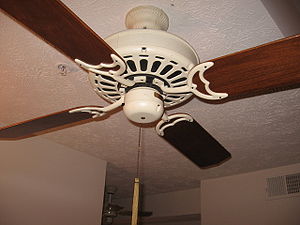A ceiling fan is a device suspended from the ceiling of a room, which employs hub-mounted rotating paddles to circulate air in order to produce a cooling or destratification effect.
Contents[hide] |
[edit] History
The first ceiling fans appeared in the 1860s and 1870s, in the United States. At that time, they were not powered by any form of electric motor. Instead, a stream of running water was used, in conjunction with a turbine, to drive a system of belts which would turn the blades of two-blade fan units. These systems could accommodate several fan units, and so became popular in stores, restaurants, and offices. Some of these systems still survive today, and can be seen in parts of the southern United States where they originally proved useful.
The electrically-powered ceiling fan was invented in 1882 by Philip Diehl (pronounced the same as "deal"). Diehl had engineered the electric motor used in the first Singer sewing machines, and in 1882 adapted that motor for use in a ceiling-mounted fan. "The Diehl Electric Fan", as it was known, operated like a common modern-day ceiling fan; each fan had its own self-contained motor unit, eliminating the need for costly and bulky belt systems.[1]
Diehl was, almost immediately, up against fierce competition due to the commercial success of the ceiling fan. However, he continued to make improvements to his invention. One such improvement, the "Diehl Electrolier", was a light kit adapted onto the ceiling fan to compensate for any light fixture(s) displaced by the installation of the ceiling fan, and/or to add extra overhead lighting to the room.
By World War I, most ceiling fans were being manufactured with four blades instead of the original two. Besides making fans quieter, this change allowed them to circulate more air, thereby making more efficient use of their motors.
By the 1920s, ceiling fans had become commonplace in the United States, and had started to take hold internationally; however, during the Great Depression, ceiling fans faded out of vogue in the U.S.[2] By the end of World War II, ceiling fans had become almost non-existent, and remained that way into the 1950s. Those which remained were considered items of nostalgia. However, the ceiling fan was still very popular in other countries, notably those with warm climates which could not afford high-energy-consuming devices, namely air conditioning.
In the 1960s, some Oriental manufacturers started exporting their ceiling fans to the United States. They caught on slowly at first, but found great success during the energy crisis of the late 1970s, since ceiling fans consume far less energy than air conditioning units.
Due to this renewed commercial success, many American manufacturers started to produce (or significantly increase production of) ceiling fans, resulting in a revival of interest in the product. The well-known Casablanca Fan Company was founded in 1974. Other popular American manufacturers at the time included the Hunter Fan Co. (which was then a division of Robbins & Myers, Inc), FASCO (F. A. Smith Co.), Emerson Electric, and Lasko; the latter two were often relabeled and sold by Sears-Roebuck.
During the rest of the 1970s, and through to the late 1980s, ceiling fans remained popular in the American market. Many small American manufacturers, most of them rather short-lived, started making ceiling fans. Throughout the 1980s, the balance of sales between American-made ceiling fans and those imported from Asian manufacturers changed dramatically. The high cost of American parts and labor became prohibitive for many consumers (for example, a basic American-made ceiling fan could cost anywhere from $100 to $250, whereas the cost of the fanciest imported fans rarely exceeded $85).
Due to the ever-reducing cost of amenities such as air conditioning, ceiling fan sales once again started to decline, beginning in the early- to mid-1990s. With the reduction in sales came a reduction in research and development, as well as features. Once-standard features (such as solid wood blades, built-in variable-speed dials, high-quality stator/rotor ("stack") motors, and die-cast steel construction) have been largely replaced by cheap, standardized parts.
While a few companies still offer high-quality ceiling fans, the majority of fans sold today consist of: (a) a poorly-ventilated import spinner motor (commonly advertised as a "###x## mm direct-drive motor"), (b) particle-board or reinforced-paperboard blades with a computer-printed laminate plastic finish, and (c) a stylized decorative motor encasement ("housing") and adornments. All of these fans cost the same approximate amount to produce (between $5 and $45), since the motors and blade materials are all standardized and widely available, and inexpensive overseas labor is used.[3] Wholesalers and retailers set prices by style however, based on current decorating trends, meaning that some fan models can be priced at a 1,000 percent or greater increase over production cost ($50 to $600 retail).[4] This stands in contrast to the 1970s, where production cost was between $60 and $150 for a top-of-the-line American-made fan, yet retail prices were generally $125-$300, making the average markup only about 200 percent.
As of 2008, the only ceiling fan still made in America with an American-made motor is the "Gillespie" model (outdoor version the "Porch Fan" model), by Marley Engineered Products of Bennettsville, SC. Casablanca Fan Co. has been bought by Hunter Fan Co., and Hunter has shipped production for both lines overseas. Emerson Electric has also shipped their ceiling fan production overseas, and both Lasko and FASCO no longer manufacture ceiling fans.



No comments:
Post a Comment